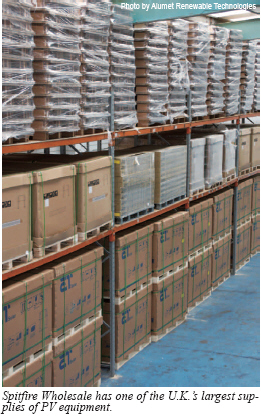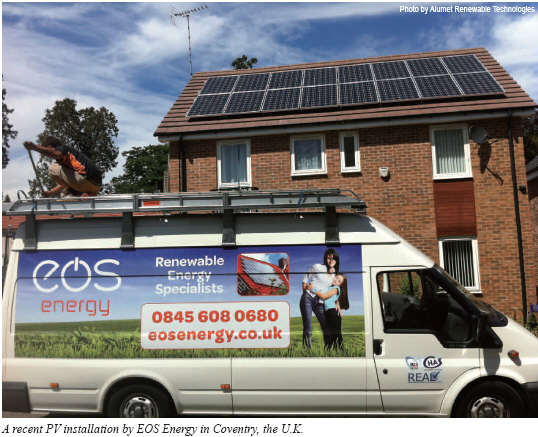By Lee Summers
.jpg)
.jpg) I am writing this on the 11th December, 2011, so forgive me if this comes across as a thinly veiled rant. The last period has been somewhat difficult for the U.K. PV industry. I am writing this on the 11th December, 2011, so forgive me if this comes across as a thinly veiled rant. The last period has been somewhat difficult for the U.K. PV industry.
Allow me to set the solar scene in the U.K. up to now. April 2010 Feed-in Tariff (FiT) begins, millions of pounds invested, thousands of companies and jobs created. What many thought was the real start of the microgeneration revolution in the U.K. 500 MW of PV installed thus far in 2011 and growing. Everyone in the industry buoyant and looking forward to a successful future. Everyone expecting a significant tariff degression in April 2012 to put PV in the U.K. on a sustainable footing for the future.
I would like to be able to finish this article here. I would like to be able to inform you that we were heading towards the scheduled degression working with our supply chain, installation teams and customers to ensure that best value was delivered up until April and that robust planning was in place for the next phase of the tariff. As many of you will I’m sure know─this is unfortunately not the end of the story for PV in the U.K. in 2011.
On Hallowe’en 2011, when I should have been helping my son into a pumpkin costume to head out trick or treating, I was instead wading through the latest fast track review of the feed-in tariff by the Coalition government. The reason for putting the Hallowe’en festivities on hold was due to the realisation that the government was proposing bringing forward the tariff degression date from April 1st 2012 to December 12th 2011. December 12th? That was six weeks away. What my team was planning for March was happening and it was happening now. Frantic telephone calls to every corner of the globe ensued. The main concern as Procurement and Technical Director for Spitfire Wholesale and EOS Energy was whether we would be able to maintain a functioning supply chain under such pressurised conditions. Then my mind turned to the installation teams. I pondered what would happen to all of the projects that we were working on that were currently in the planning system? Millions of pounds worth of work was very quickly going up in smoke. Thoughts of that nature persisted throughout the last day of October.
As November began, it became clear that I was not the only one who was concerned. Panic buying was the order of the day. Industry leading wholesalers of equipment, such as ourselves, sold out of certain product lines within hours as installation firms scrambled to secure access to equipment. Rumours abounded of Dutch auctions for equipment, promises being broken and the biggest problem of all─no one could get any mounting rail.
.jpg)
Why the Panic You May Ask?
The government had based the proposals in the fast track review consultation on the fact that material costs had dropped significantly over the past eight months. The proposed consumer returns had risen from approximately 5% to somewhere in the region of 14%. As an industry, we were acutely aware of this fact and argued in favour of a reduction in the tariff during the previous fast track review in July. Unfortunately, this advice was not heeded by government at the time and the result of this ignorance is a knee-jerk reaction causing, at least, disruption and, at worst, bankruptcy through the PV industry in the U.K.
Fortunately, Spitfire and EOS Energy have the right people and supply chains in place to have reacted admirably to the challenge that was presented. I sit here now very tired, but proud to have been through this last 6 weeks and to have come out the other side prospering. I wish that I was comfortable that we won’t be put in this situation again.
So is this the end of the road for the U.K. PV industry? We certainly do not believe that it is. Unfortunately, the media in the U.K. would have people believe otherwise. Reports in various broadsheet newspapers have led many to believe that with the proposed level of cuts the payback period on a 4 kWp domestic system will be somewhere in the region of 20 years. If that were true, I would be looking for another employer. We have already managed to work with the proposed 21p pence figure for sub-4 kWp projects to achieve payback periods of 8 years with an IRR of around 4.8-5%. This effectively replicates the market proposal of 18 months ago and people were investing in systems then.
.jpg)
As you read this the proposed figure of 21p will hopefully have been decided. This is a point which has not been widely publicised. This debacle of a fast track consultation simply proposes the figure. As I write this article, we are in a period of limbo as sellers of PV systems to consumers in the U.K. If we ‘sell’ at 21p right now and base our payback projections on these figures we are in effect mis-selling. As we don’t expect a result from the consultation until early February we are in a hiatus period where very few sales can be closed on financial projections. The government has, therefore, not only thrown the industry into disarray due to the timing of the consultation, but has further reduced our ability to stay afloat by putting us into a position where cash flow will be severely restricted for the next 2 months due to lead times around system installation.
 Again something which, as you read this, has probably been decided which gives the industry cause for concern is the energy efficiency requirement proposed in the consultation. The measures proposed states that for new installations (after April 2012) to claim the full (proposed) figure of 21p the domestic property must reach a minimum Energy Performance Certificate (EPC) rating of ‘C’. If the EPC rating is lower than ‘C’ then the applicant will only be able to claim 9p per kWh. At EOS Energy and Spitfire, we are passionate about sustainability and believe it only right that PV installations should be linked to energy efficiency. This proposed amendment to the FiT scheme for PV would have the most dramatic effect of all on the domestic U.K. PV industry. Again something which, as you read this, has probably been decided which gives the industry cause for concern is the energy efficiency requirement proposed in the consultation. The measures proposed states that for new installations (after April 2012) to claim the full (proposed) figure of 21p the domestic property must reach a minimum Energy Performance Certificate (EPC) rating of ‘C’. If the EPC rating is lower than ‘C’ then the applicant will only be able to claim 9p per kWh. At EOS Energy and Spitfire, we are passionate about sustainability and believe it only right that PV installations should be linked to energy efficiency. This proposed amendment to the FiT scheme for PV would have the most dramatic effect of all on the domestic U.K. PV industry.
Approximately 4% of domestic dwellings in the U.K. are currently EPC rated at band C or above. The Coalition government’s flagship retrofit programme ‘The Green Deal’ is not scheduled to begin until at least the Autumn of 2012, so what is the PV industry meant to do in the meantime? We have diversified into whole house retrofit solutions and are keen to be at the forefront of energy efficient retrofit solutions across a broad range of sectors. Not giving us a mechanism to effect this change will kill all of the good work we have done up until now. There is an opportunity here for the Government to utilise the skills and ethos of many reputable solar companies in the U.K. as heralds for the Green Deal. We understand energy efficiency and we understand how to sell it. The problem is too much too soon here. If the Government were looking to kill the domestic PV industry overnight─ the mandatory EPC level C banding will have been the perfect assassin.
There have been some positives to come out of this poorly handled review. The solar industry in the U.K. seems to have at last found an almost united voice. The Micropower Council, British Photovoltaic Association and the Solar Trade Association seem to have found common ground on which to build a coherent and unified message to government. This can only benefit the industry as a whole going forward. There are well-informed people in those organisations that have direct contact with the Department for Energy and Climate Change (DECC) and that should hopefully ensure that, at the very least, the industry’s voice is heard.
There are numerous other positives that we see. EOS Energy is already in discussion with numerous clients discussing the possibility of multi-megawatt installations. The cost of material and our ability to build efficiencies into our installation method has meant that Renewables Obligation (ROs) or ROOFIT schemes are viable once again. We have a proven track record of delivering these projects and look forward to delivering more moving forward.

We also see opportunity in the commercial rooftop space for the reasons mooted above. We are already able to offer commercial clients payback period that any well established business will be comfortable with. We are also offering fully integrated energy efficiency packages for these clients. Solar PV is obviously one of the tools we use to help clients combat their carbon footprints, but we also offer a wide range of solutions based upon site specific needs. This can range from energy efficient lighting all the way through to complete re-cladding services. We see this integrated, whole building approach as key to the future of the industry. Diversification into other low carbon technologies should hopefully enable us to ride out the fall out of any further unexpected Government cuts.
So is this the end of the road for U.K. PV? We certainly do not think so. Working together with our supply chain and our clients, we are able to offer solutions which are appropriate to their needs, providing pay back periods with which they are comfortable.
I challenge the rest of the industry to move on from this debacle and work hard to get a positive message out into the market place.
Lee Summers is Technical Director of Warwickshire-based PV specialist Alumet Renewable Technologies (www.alumet.co.uk) and its subsidiary companies EOS Energy and Spitfire Wholesale. Summers has previously been an environmental manager as well as a project manager on experimental eco-homes, before dedicating himself to driving value and quality into the U.K. solar PV industry.
For more information, please send your e-mails to pved@infothe.com.
ⓒ2011 www.interpv.net All rights reserved. |



